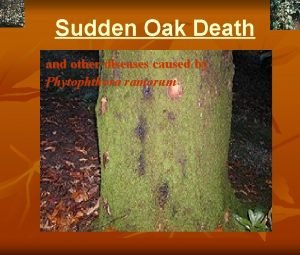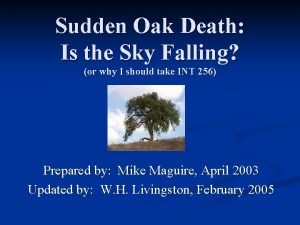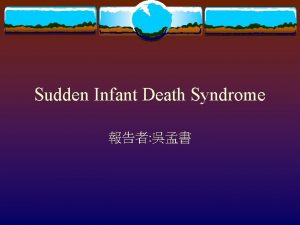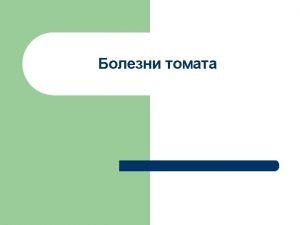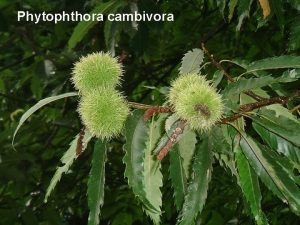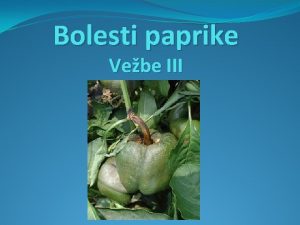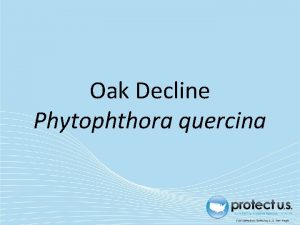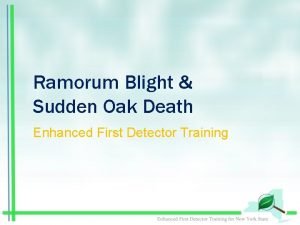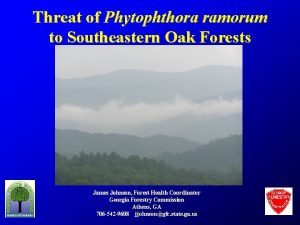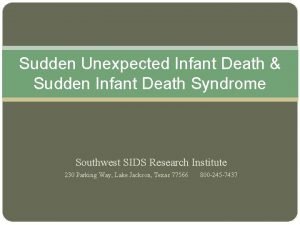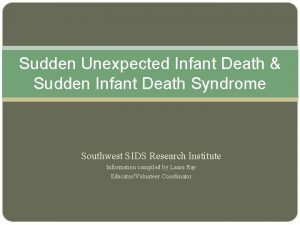Sudden Oak Death Phytophthora ramorum is the cause








- Slides: 8

Sudden Oak Death • • Phytophthora ramorum is the cause of both Sudden Oak Death, a forest disease that has resulted in widespread dieback of several tree species in California and Oregon forests, and Ramorum blight, which affects the leaves and twigs of numerous plants in forests and nurseries Since the mid 1990 s, P. ramorum has caused substantial mortality in tanoak trees and several oak tree species (coast live oak, California black oak, Shreve oak, and canyon live oak), as well as twig and foliar diseases in numerous other plant species, including California bay laurel, Douglas-fir, and coast redwood

Symptoms • Infections caused by P. ramorum must be confirmed in the laboratory utilizing either culture techniques or DNA analysis for detection of pathogen DNA. They cannot be identified on field symptoms alone. However, infected plants typically are found near other infected plants, so when oaks or other hosts with characteristic symptoms of Sudden oak death are found within forests or woodlands where the disease already has been confirmed, these plants should be suspected to be infected with P. ramorum. Oaks growing farther from infested forests are not as likely to be infected unless infected material or nursery stock has been brought to the area. • There are two categories of hosts for P. ramorum—trunk hosts and foliar hosts. Trunk hosts, such as tanoaks and oaks, get infections in their bark. These trunk infections often are fatal. Other organisms often attack diseased oak and tanoak trees once P. ramorum has weakened them. These include ambrosia beetles (Monarthrum scutellare and M. dentiger), bark beetles (Pseudopityophthorus pubipennis), and a sapwood decay fungus (Annulohypoxylon thouarsianum). Though these attacks are secondary to the original P. ramorum infection, they act to further weaken the trunk and can hasten the tree’s death. • On foliar hosts—such as California bay laurel, rhododendron, or camellia—symptoms can range from leaf spots to twig dieback, but these hosts rarely die from the infection. Rather than Sudden oak death, a P. ramorum infection on these hosts is known as Ramorum blight. Symptoms of P. ramorum infection on some key hosts are detailed below.

(A) Tanoak mortality near Bolinas Ridge, Mt. Tamalpais, Marin County, California. Photo courtesy: Janet Klein, Marin Municipal Open Space District. (B) Eradication of sudden oak death in Curry County, Oregon, through slash and burn. Photo courtesy: Oregon Department of Forestry.

Typical symptoms observed on different hosts of Phytophthora ramorum. (A) Bleeding canker of tanoak in the exposed inner bark (phloem) after removal of the outer bark: note typical lesions with clearly differentiated margins; (B) leaf tip necrosis or leaf spots on leaf margins of California bay laurel; (C) rhododendron—arrow marks necrosis of leaf petiole; (D) leaf necrosis on nursery ornamental rhododendron.

SOD biology • • • P. ramorum is an unusual Phytophthora The spores can be transmitted through the air; this could be an epidemiologically significant trait Most Phytophthoras that affect trees are soil organisms which attack the roots. P. ramorum is unique because it apparently spreads aerially by way of foliage on host plants Can survive in rain water, soil and leaf litter It infects foliar hosts and can then be splashed to the oaks Once spores get into the trunk through the bark, it destroys the cambium, girdling and killing the tree within months The pathogen can be transported from location to location easily by way of infected nursery stock, soil, and bark from SOD infected areas SOD affects a wide variety of hosts, not only oaks but several other species of trees and shrubs as well. A- Sporangia, B-zoospore, Cchlaymedospore, D-oospore

Generic life cycle of Phytophthora ramorum, broadly outlining the major life stages. Note that the sexual cycle to date has only been described under controlled conditions in the laboratory and has not been documented in nature

LIFE CYCLE/BIOLOGY OF PATHOGEN • Phytophthora species are funguslike organisms, related to algae, which occur worldwide. They are water loving and produce plentiful spores in moist or humid conditions. Most known Phytophthora species are soil-dwelling root pathogens; however, P. ramorum acts primarily as a leaf pathogen. In California, it thrives in the coastal tanoak/redwood forests and oak woodlands within the fog belt. Nurseries outside of these cool, moist areas often create microclimates that mimic an environment supportive of P. ramorum and allow it to grow and spread far from the coast. • While most nonoak hosts are not killed by the disease, they do play a key role in the spread of P. ramorum, acting as a breeding ground for inoculum that can spread through water, wind-driven rain, plant material, or human activity. Oaks are considered terminal hosts, since the pathogen does not readily spread from intact bark cankers; they become infected only when exposed to spores produced on the leaves and twigs of neighboring plants. • Research in California forests has shown that the greatest predictor of P. ramorum canker on oak is the presence of California bay laurel (Umbellularia californica). Pathologists believe P. ramorum drips or is blown down onto oak trunks from neighboring bay leaves when it rains. Once on the oak trunk, P. ramorum uses natural openings in the bark to colonize the bark tissues, killing cells and clogging water and nutrient transport vessels.

SOD management • Prescribed fire – Eliminate the shrub hosts • Inspection and sanitation – Destroy alternate host, a known host of P. ramorum – Inspect and destroy nursery infected material • Quarantines – Early diagnosis – Monitoring • Fungicides • Public participation
